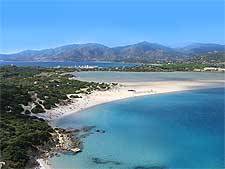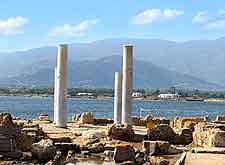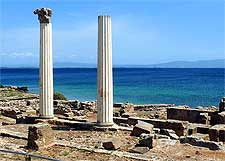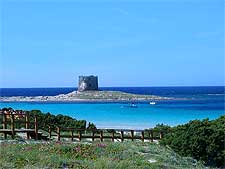Sardinia History Facts and Timeline
(Sardinia, Italy)

Sardinia's earliest history may date to the Neolithic era, somewhere in the region of 6000 BC. However, evidence of any permanent settlement on the island is rather fragmentary.
By 1500 BC, a number of small settlements had been established here, populated by people from the Italian mainland, particularly Etruria and the Iberian Peninsula. Over time, these groups began to come together in terms of their language and various different customs. They lived in villages that were built in the shadow of large stone fortresses known as 'nuraghes'. Many of these can still be seen today.
The Island's Early History
At around 1000 BC, Sardinia witnessed the arrival of the Phoenicians, who began to land here during their frequent trading missions. The island was seen as a safe place to anchor at night or in bad weather. Many of these 'ports of call', such as Bosa and Torres, grew to become market towns that were inhabited by a mix of Phoenician families and those related to native Sardinians who came from inland.

In the 6th century BC, Phoenician attempts to move further inland led to the native Sardinians calling in an ally to help them. The Carthaginians conquered the island's most mountainous region.
For almost three centuries, their civilisation flourished on the island, alongside that of the native Nuragic culture. Then, in 283 BC, Sardinia fell into the hands of the Romans. They enlarged the island's towns on the coast and conquered the native inland settlements.

In the years that followed the fall of the Roman Empire, Sardinia fell prey to first the Vandals of Africa and then Byzantine soldiers. Christianity spread through most of the island, although it struggled to take hold in the more remote mountain areas.
From the 8th century AD, attacks on Sardinia became more and more frequent. To better defend itself, the island was divided into four states - Arborea, Cagliari, Gallura and also Torres. Each state had its own fortified boundaries, governing parliament, bylaws and language.

History of the Island in the Middle Ages
The kingdom of Cagliari came to an end in 1258, when it became a colony of
Pisa. In 1288, Torres suffered a similar fate when its territory was divided up between wealthy Genoese and Arborean families. In the same year, Gallura also became part of Pisa. The kingdom of Arborea was to fare better and it lasted for around 500 years.
In 1323, Jaume II of Aragon formed an alliance with Arborea's king and occupied Cagliari and Gallura. He called these territories the 'Kingdom of Sardinia and Corsica'. Some 50 years later, Pere IV of Aragon gave the kingdom its own parliament. Later, a degree of self-government was added, along with judicial independence.
In the early 15th century, the King of Sicily, who was also the heir to the Aragon throne, conquered the whole island. On his death, ownership of Sardinia was transferred to the Castilians. Thus, Sardinia became a Spanish territory and to defend the island, a series of watch towers were built along its coast.

From the 18th Century to Today
In 1708, at the time of the Spanish War of Succession (1701 to 1714), Sardinia passed into Austrian control. Ten years later, it was given to the Dukes of Savoy. During the Napoleonic Wars period of history, the dukedom took refuge in Cagliari for some 15 years. In the mid-1800s, Sardinia united with Piedmont so that there could be a single parliament in
Turin, while in 1861, the island became part of the newly formed Italian state.
During World War Two, Cagliari suffered from heavy Allied bombardment. After the war, in 1946, Sardinia became one of 20 different Italian regions. Its provinces of Cagliari, Nuoro, Oristano and Sassari are closely related to the original four medieval states.
In more recent years, tourism has come to play a significant role in the island's economy. In 2004, the founder of successful European Internet giant Tiscali, Renato Soru, became president of the island.
 Sardinia's earliest history may date to the Neolithic era, somewhere in the region of 6000 BC. However, evidence of any permanent settlement on the island is rather fragmentary.
Sardinia's earliest history may date to the Neolithic era, somewhere in the region of 6000 BC. However, evidence of any permanent settlement on the island is rather fragmentary. In the 6th century BC, Phoenician attempts to move further inland led to the native Sardinians calling in an ally to help them. The Carthaginians conquered the island's most mountainous region.
In the 6th century BC, Phoenician attempts to move further inland led to the native Sardinians calling in an ally to help them. The Carthaginians conquered the island's most mountainous region. In the years that followed the fall of the Roman Empire, Sardinia fell prey to first the Vandals of Africa and then Byzantine soldiers. Christianity spread through most of the island, although it struggled to take hold in the more remote mountain areas.
In the years that followed the fall of the Roman Empire, Sardinia fell prey to first the Vandals of Africa and then Byzantine soldiers. Christianity spread through most of the island, although it struggled to take hold in the more remote mountain areas.
